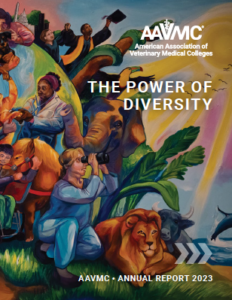MEDIA CONTACTS:
Jeff Douglas or Jeanne Johnson
Phone: 202/371-9195, x144
Email: jdouglas@aavmc.org or jjohnson@aavmc.org
WASHINGTON, D.C., July 12, 2021 — Gene editing in agricultural animals has the potential to unleash enormous gains in productivity. But in order for those gains to be realized, “a remodeling of the federal regulatory landscape is needed.” That’s the conclusion of a panel of experts convened by the American Association of Veterinary Medical Colleges (AAVMC) and the Association of Public and Land-grant Universities (APLU) that spent the past 18 months studying the issue.
The “AAVMC/APLU Gene Editing in Agriculture Task Force Report” suggests current regulatory protocols have not kept up with technological change and must be modernized in order for society to realize the many benefits of new scientific capabilities. Regulatory reform will help address the food security and sustainability needs of a global population expected to reach 10 billion people by 2050.
“For the promises of applying gene editing in livestock to be realized, federal regulatory approval and monitoring processes that are rooted in science and streamlined with the pace of development, as well as public acceptance of food derived from gene edited animals, are essential,” authors say in the report. “Thus, a remodeling of the federal regulatory landscape is needed for the U.S. to sustain its place as a global leader and innovator in the animal agriculture sector and keep pace with the exponentially expanding global human population.”
Currently the Food and Drug Administration regulates genetic work on food animals as an “animal drug” under protocols developed during the early phases of the Biotechnology Revolution. The USDA regulates these technologies with crops.
The report contains several specific recommendations for regulatory officials and lawmakers to consider as they envision “what a modernized and progressive framework for the regulation of gene edited livestock in the U.S.” should be:
- Update the existing FDA regulatory framework (currently based upon processes established for transgenic technologies that are out of step with state-of-the-art gene editing technologies) and develop a coordinated, streamlined, fact-based, and cost-effective assessment and approval process between the USDA and FDA to ensure safe food.
- Develop an evidence and logic-based decision-making protocol for gene editing applications that is regulated separately from transgenic-based GMOs which result from the integration of recombinant DNA.
- Develop streamlined assessment and approval processes that categorize gene editing applications based on: a) the type of genomic change being created, b) the method used for creating the genomic change, c) the impact on the welfare of the animal, and d) the potential for negative impact on the environment.
- Develop a regulatory channel for approval of gene-edited agricultural animals with genomic structures that could have arisen in nature as safe for human consumption.
“Gene editing has the capacity to create transformational change in our food production systems,” said Dr. Noelle Cockett, president of Utah State University, a renowned geneticist, and chair of the task force. “But in order to realize those benefits in production and safety, we need a regulatory structure that has kept pace with technology. Our task force has thoughtfully and carefully considered many different aspects of this issue, including perspectives from the scientific and agricultural communities, and we have made our recommendations. We hope this work will meaningfully inform the work of government officials as they develop the best public policy in this area.”
For more than 10,000 years, humans have been using selective breeding in domesticated animals to achieve desired characteristics like improved growth and resiliency, according to the report. While it has been useful over the centuries, selective breeding is time consuming and requires multiple generations before results can be achieved.
The advent of biotechnology substantially advanced those capabilities. Following the invention of recombinant DNA technology, scientists were able to quickly produce generations of animals with desired characteristics by fusing strands of DNA that coded for those changes through a process known as transgenesis.
The genomic structure of transgenic animals could not occur in nature through normal mutagenic processes and transgenic animals were eventually regulated by the federal government as Genetically Modified Organisms (GMO’s). Public attitudes regarding the safety of GMO’s have wavered from uncertainty to negative, which has impaired the widespread use of that technology.
Meanwhile, scientific advancements led to the development of CRISPR technology (clustered regularly interspaced short palindromic repeats), which enables scientists to precisely “edit” existing strands of DNA in a way that immediately generates the desired genomic characteristics. Importantly, these genetic changes can and do occur naturally in the world through normal mutagenic processes.
“Both the technical science and intended outcomes of gene editing are substantially different compared to transgenesis,” according to the authors. “As such, regulatory statutes should not be applied as a ‘one size fits all’ model; rather, contextual categorizing of the genetically altered animals that allows for fluidity and applying logic-based decision making, while still ensuring safety, is needed.”
The expert panel also outlined a series of steps that could pave the way for fully reaping the potential benefits of gene editing technology:
- Establish a national coalition of scientific experts, bioethicists, and engagement specialists from APLU and AAVMC member institutions to serve as a sounding board and think-tank related to the modernization of the existing federal regulatory framework.
- Engage with federal legislators, staffers, and the White House Office of Science and Technology Policy (OSTP) and inform them on key issues related to regulatory approval and monitoring processes for gene editing applications in livestock.
- Distribute the task force report to stakeholder organizations and agencies like U.S. Land-grant universities, the FDA, the USDA, the Food and Agricultural Organization (FAO) of the United Nations, the Gates Foundation, and others.
- Establish a University Research Consortium of scientific experts developing gene editing applications in livestock that will facilitate collaborative research and educational initiatives.
AAVMC/APLU Gene Editing in Agriculture Task Force members include Cockett; Dr. Jon Oatley, Washington State University; Dr. Bhanu Telugu, Universities of Missouri and Maryland; Dr. Londa Nwadike, Kansas State University and University of Missouri; Dr. Jonathan Beever, University of Tennessee; Dr. Rex Dunham, Auburn University; and Dr. James Murray, University of California, Davis; Dr. Kathy Simmons, National Cattlemen’s Beef Association; and Clint Nesbitt, Biotechnology Innovation Organization (BIO). The task force was staffed by AAVMC Director for Governmental Affairs Mr. Kevin Cain.
“We’re pleased to partner with the APLU on a project that has such vast implications for agricultural productivity and food security,” said AAVMC CEO Dr. Andrew T. Maccabe. “Working closely with other stakeholders and thought-leaders and using evidence-based facts, scientists working in our member institutions have been able to make an important contribution in a converging area of science, technology and public policy that needs to be addressed.”
“Gene editing is a key tool in our effort to foster greater food security across the world and produce healthier, more sustainable food,” APLU President Peter McPherson said. “Having a regulatory framework to ensure the safety and integrity of such food is important, but the current system is outdated and not constructed to deal with the modern state of gene editing technology and processes. In partnering together, our nation’s public and land-grant universities and veterinary colleges have charted a path forward that will allow this field to advance while maintaining appropriate and effective oversight.”
The APLU and the AAVMC decided to take action in this area following inquiries from members of Congress to then Food and Drug Administration Acting Commissioner Norman E. Sharpless concerning current regulatory processes. That provided the impetus for the AAVMC and the APLU to organize a fall 2019 symposium for leading scientists and other scholars called “Gene Editing in Livestock: Looking to the Future.” During that event, 23 of the nation’s leading experts from academia, government, industry, and professional groups gathered to examine a series of questions ranging from the nature and safety of this promising technology to its ethical implications.
Symposium participants concluded that work with animal and plant genomes has vast potential for limiting disease and increasing productivity, but agreed that appropriate regulatory processes should be thoroughly considered and structured. That led to the formation of the task force.
The APLU and the AAVMC previously teamed up on a multi-year effort designed to address the growing antimicrobial resistance problem. That led to the establishment of the National Institute of Antimicrobial Resistance Research and Education (NIARRE), which is based at Iowa State University and operates in collaboration with a consortium of partner universities and medical institutions.
ABOUT THE AAVMC
The member institutions of the American Association of Veterinary Medical Colleges (AAVMC) promote and protect the health and wellbeing of people, animals and the environment by advancing the profession of veterinary medicine and preparing new generations of veterinarians to meet the evolving needs of a changing world. Founded in 1966, the AAVMC represents more than 40,000 faculty, staff and students across the global academic veterinary medical community. Our member institutions include Council on Education (COE) accredited veterinary medical colleges and schools in the United States, Canada, Mexico, the United Kingdom, Europe, Asia, Australia, and New Zealand as well as departments of veterinary science and departments of comparative medicine in the U.S.
ABOUT THE APLU
APLU is a research, policy, and advocacy organization dedicated to strengthening and advancing the work of public universities in the U.S., Canada, and Mexico. With a membership of 244 public research universities, land-grant institutions, state university systems, and affiliated organizations, APLU’s agenda is built on the three pillars of increasing degree completion and academic success, advancing scientific research, and expanding engagement. Annually, member campuses enroll 5.0 million undergraduates and 1.3 million graduate students, award 1.3 million degrees, employ 1.3 million faculty and staff, and conduct $49.2 billion in university-based research.
– 30 –





SHARE